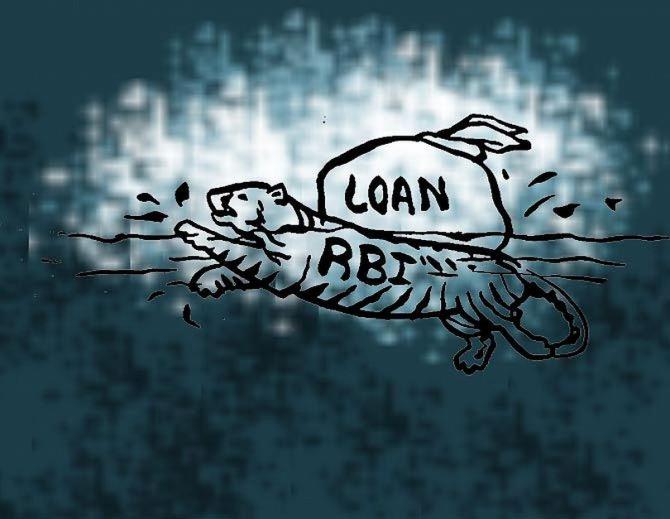On November 12, 2021, the Reserve Bank of India (RBI) decided to ring in uniformity in asset classification and income recognition across all lending institutions.

Shadow banks, or non-banking financial companies (NBFCs), like commercial banks, are to test non-performing assets (NPAs) on a daily basis and upgrade them to “standard assets” only when interest and principal arrears are settled by borrowers.
This is going to create all manner of headaches for shadow banks and their clientele.
Says Y S Chakravarti, managing director and chief executive officer (CEO), Shriram City Union Finance: “NPA levels will go up, especially of small borrowers.
"They have a varied cash-flow pattern which has been worsened by Covid.”
Historically, once such borrowers slip on EMIs (equated monthly instalments), they find it difficult to pay the bundled current EMI along with arrears.
“Generally, customers pay EMI arrears over an extended period, and without even getting into the restructuring, or rescheduling of accounts.
"This may worsen in times of stress,” he adds.
False equivalence
NBFCs classify an account as stage three, or special mention account (SMA-3), when it is overdue for more than 90 days.
Typically, for monthly payments, this would be when there are three or more overdue instalments.
However, when the borrower part-pays, such that the overdue is less than three instalments, the account is classified as a “standard asset” (that is, not an NPA), even though it remains in the overdue category, as not all overdue has been cleared.
The RBI’s November 12 notification said stage-three assets are to be “standard assets” only when all overdue is cleared.
NBFCs ramp up collection activity between the due date and the month-end, which is why their overdue reduces by the end of the month.
Now, this flexibility is no longer available. CRISIL Ratings reckons that a significant proportion of loans in the 60-90 days bucket may now slip into the over 90-days overdue bucket and will have to be recognised as NPAs.
It expects gross NPAs to increase by 25-300 bps (based on the asset class) because of the new recognition norm.
Home- and gold-loans will be the least impacted; but unsecured loans and loans to MSME (micro, small and medium enterprise) will bear the brunt.
Gurpreet Chhatwal, managing director at CRISIL Ratings, puts it mildly.
“Competition from banks will intensify. Asset-quality worries have also manifested due to recent regulatory clarifications and uncertainty over the performance of the restructured book.
"Growth will be driven by NBFCs with strong parentage and better funding access in the two largest segments: home loans and vehicle finance.”
The RBI stance also flies in the face of business realities.
Most MSMEs have seen a delayed payment cycle, and spend much time and resources on the collection of dues owing to the pandemic.
It’s the same for rural customers, due to delays in sales of their produce, caused by major agri-supply chain disruptions.
So, too, for self-employed customers like plumbers and carpenters with monthly incomes of under Rs 20,000 and having two to three instalments.
According to the Confederation of Indian Industry’s (CII’s) National Forum on NBFCs, such customers lack the ability to make three or four EMI payments together.
Take truck operators: stagnant freight rates and higher variable costs — mainly fuel — have led to a decline in profitability, depriving them of the ability to settle more than one EMI out of the two or three due.
Worse, under the revised RBI norms, customers could be tagged as NPAs for no fault of theirs.
Nearly 40-45 per cent of NBFC collections are in cash — from the remotest parts of the county — and loan repayments, anyway, are not done on due dates.
This is because it calls for multiple personal visits to borrowers’ residences or business locations; and this process is also regulated in terms of time and place of visit.
So, a delay in the deposition and updating of receipts by a few days owing to logistics may lead to borrowers being classified as NPAs.
The follow-on effects would lead to “a large section of MSME borrowers being categorised as SMA-accounts or NPAs, and the stigma would immediately exclude them from fresh borrowing. It would be a double-whammy for this segment,” says Shachindra Nath, executive chairman and managing director of U GRO Capital.
And “uniformly, all lenders are avoiding giving fresh credit to customers who have availed restructuring, and this could potentially disrupt MSMEs’ regular working capital cycle,” he adds.
Differentiated approach
Vimal Bhandari, executive vice-chairman and CEO, Arka Fincap, reckons that “while this realignment of norms between banks and NBFCs is welcome, it will cause some pain for the lower-rung NBFCs and borrowers in the MSME space.
"Maybe, the possible disruption may have got mitigated if the transition had been done over a period of time, with a glide path.”
The RBI’s Financial Stability Report (FSR, December 2021) says banks’ exposure to NBFCs recovered in Q2:2021-22, after a steep decline in the preceding quarter.
The trend for state-run NBFCs is interesting. Bank lending to such entities “reflected a more active usage of credit limits…they have a dominant position in the NBFC space, accounting for 48.6 per cent of the credit extended and 81 per cent of the credit to the industries sector,” the FSR notes.
Their ability to actively tap banks’ credit lines is based on the assumption that they are backed by the sovereign.
The gross NPA ratio for NBFCs, which had declined in September 2020 owing to the standstill on asset classification, rose to 6.5 per cent at end-September 2021.
The share of state-run NBFCs in GNPAs is 31.6 per cent! Clearly, they continue to get bank finance despite having the lion’s share of NPAs.
State-run NBFCs are also put on a different regulatory pedestal.
As per the RBI circular Withdrawal of Exemptions Granted to Government-owned NBFCs (May 31, 2018), they are still in the process of attaining the minimum capital adequacy ratio.
And so, they are also not to be placed in the “Upper Layer” of the RBI’s Scale-Based Regulation (SBR), to be effective from October 1, 2022.
This layer comprises “NBFCs which are specifically identified by the RBI as warranting enhanced regulatory requirement based on a set of parameters”.
The CII appears to be indirectly referring, in its communication to the RBI, to the breather given to state-run NBFCs, and the generous timeline for adherence to the SBR.
It has requested that “the new norms for SMAs/NPA classification may be aligned with the date of effect of SBR i.e. October 1, 2022 for NBFCs in all layers”, arguing that this approach will give NBFCs enough time to implement changes in their IT systems.
Clearly, there are headwinds on the horizon.











